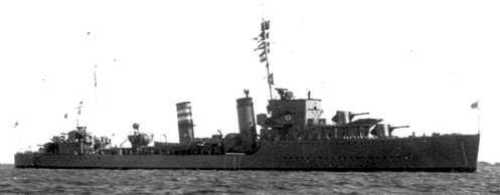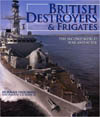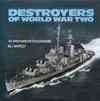| Navy | The Royal Navy |
| Type | Destroyer |
| Class | B |
| Pennant | D 06 |
| Mod | Flotilla leader |
| Built by | Vickers Armstrong (Barrow-in-Furness, U.K.) |
| Ordered | 22 Mar 1929 |
| Laid down | 1 Oct 1929 |
| Launched | 10 Jul 1930 |
| Commissioned | 20 Mar 1931 |
| Lost | 1 Jun 1940 |
| Loss position | 51° 04'N, 2° 08'E |
| History | On 1 June 1940 HMS Keith (Capt. Edward Lyon Berthon, RN, also Commanding officer of the 19th Destroyer Flotilla) was sunk by German Stuka dive bombers off Dunkirk, France while she was participating in the evacuaton of the British Expeditionary Force from France. |
Commands listed for HMS Keith (D 06)
Please note that we're still working on this section
and that we only list Commanding Officers for the duration of the Second World War.
| Commander | From | To | |
| 1 | Capt. Alfred Jerome Lucian Phillips, RN | 31 Jul 1939 | 6 Sep 1939 |
| 2 | Cdr.(Retd.) Henry Thurston Wake Pawsey, OBE, RN | 6 Sep 1939 | 15 Feb 1940 |
| 3 | Capt. David James Robert Simson, RN | 15 Feb 1940 | 23 May 1940 (+) |
| 4 | Capt. Edward Lyon Berthon, DSC, RN | 27 May 1940 | 1 Jun 1940 |
You can help improve our commands section
Click here to Submit events/comments/updates for this vessel.
Please use this if you spot mistakes or want to improve this ships page.
Notable events involving Keith include:
7 Oct 1939
Around 1000A/7, the aircraft carrier HMS Hermes (Capt. F.E.P. Hutton, RN) departed Plymouth for the Brest area to make rendezvous with French warships and then on to Dakar. On departure from Plymouth HMS Hermes was escorted by the destroyers HMS Keith (Cdr.(Retd.) H.T.W. Pawsey, OBE, RN) and HMS Vesper (Lt.Cdr. W.F.E. Hussey, DSC, RN).
Around 1915A/7, HMS Hermes anchored off Brest. The destroyers then returned to Plymouth.
Around 2115A/7, HMS Hermes got underway again to proceed to the Dakar area in company with French warships. These were the battlecruiser Strasbourg (Capt. J.F.E. Bouxin) and the destroyers Le Fantasque (Capt. P.A.B. Still), Le Terrible (Cdr. A.E.R. Bonneau) and L’Audacieux (Cdr. L.M. Clatin). This force was known as 'Force N'.
Around 1430A/10, the heavy cruisers Algerie (Capt. L.H.M. Nouvel de la Fleche) and Dupleix (Capt. L.L.M. Hameury) and the destroyers Maille Breze (Cdr. H.M.E.A. Glotin) and Vauquelin (Cdr. R. Jaujard) joined.
The Force arrived at Dakar on 14 October 1939. (1)
9 Oct 1939
Around 2100 hours the British destroyers
HMS Griffin (Lt.Cdr. J. Lee-Barber, RN with Capt. G.E. Creasy, MVO, RN aboard), HMS Gipsy (Lt.Cdr. N.J. Crossley, RN), HMS Keith (Cdr. H.T.W. Pawsey, OBE, RN), HMS Boadicea (Lt.Cdr. G.B. Kingdon, RN) and the Polish destroyer Grom (Lt.Cdr. A. Hulewicz, ORP) were ordered to leave Harwich and establish a patrol in the North Sea. Shortly before that, a German He 59 seaplane dropped two magnetic mines nearby, but there was no time for searching. HMS Gipsy hit one of those mines which tore her into two pieces. Most of the survivors were picked up by HMS Griffin and HMS Keith. (2)
2 Nov 1939
A submarine was reported near Margate Buoy and the destroyers HMS Keith (Cdr.(Retd.) H.T.W. Pawsey, OBE, RN), HMS Blanche (Lt.Cdr. R.N. Aubrey, RN) and HMS Gurkha (Cdr. F.R. Parham, RN) were ordered to hunt this submarine. No contact was obtained though.
25 Nov 1939
Convoy HXF 10.
This convoy departed Halifax on 25 November 1939.
The convoy was made up of the following merchant vessels; Beaverdale (British, 9957 GRT, built 1928), Cairnesk (British, 5007 GRT, built 1926), Flandre (French, 8503 GRT, built 1914), Henri Desprez (French, 9805 GRT, built 1932), Manchester Citizen (British, 5343 GRT, built 1925), Nova Scotia (British, 6796 GRT, built 1926), San Alvaro (British (tanker), 7385 GRT, built 1935), Seminole (British (tanker), 10389 GRT, built 1936), Thiara (British (tanker), 10364 GRT, built 1939) and Winnipeg (French, 9717 GRT, built 1918).
On departure from Halifax the convoy was escorted by the armed merchant cruiser HMS Letitia (Capt.(Retd.) W.R. Richardson, RN) and the destroyers HMCS Skeena (Capt. H.T.W. Grant, RCN) and Assiniboine (Cdr. E. Mainguy, RCN).
The two Canadian destroyers parted company in position 44°38'N, 61°28'W, to return to Halifax at midnight during the night of 25/26 November 1939.
Around 0700Q/26, in position 44°45'N, 66°18'W, the Beaverdale parted company with the convoy to return to Halifax due to engine trouble.
Around 1100Z/4, in position 49°51'N, 13°35'W, the destroyers HMS Versatile (Cdr.(Retd.) T.A. Hussey, RN) and HMS Witherington (Lt.Cdr. G.C. Fryer, RN) joined the convoy.
Around 0800Z/5, in position 49°40'N, 08°50'W, the convoy split into two sections.
The Irish Sea / West Coast section was made up of the following ships; Manchester Citizen, Nova Scotia and Winnipeg. This section was escorted by HMS Versatile which arrived at Liverpool in the evening of 6 December 1939.
The other ships made up the Channel / East Coast section. They were escorted by HMS Letitia and HMS Witherington. Around 0200Z/6, HMS Letitia parted company off St. Catherines Point, Isle of Wight, to proceed to Southampton. Around 1000Z/6, HMS Witherington parted company to proceed to Liverpool where she arrived in the morning of 7 December 1939. She had been relieved by the destroyer HMS Keith (Cdr.(Retd.) H.T.W. Pawsey, OBE, RN). Around 1330Z/6, the Flandre and
22 Jan 1940
Convoy HX 17.
This convoy departed Halifax on 22 January 1940.
It was made up of the following merchant vessels; Agia Marina (Greek, 4151 GRT, built 1912), Anadara (British (tanker), 8009 GRT, built 1935), Antonios Chandris (Greek, 5866 GRT, built 1918), Athelduke (British (tanker), 8966 GRT, built 1929), Balmoralwood (British, 5834 GRT, built 1937), Beaverdale (British, 9957 GRT, built 1928), Boston City (British, 2870 GRT, built 1920), Bretwalda (British, 4906 GRT, built 1939), Brockley Hill (British, 5287 GRT, built 1918), Cadillac (British (tanker), 12062 GRT, built 1917), Crispin (British, 5050 GRT, built 1935), D.L. Harper (British (tanker), 12223 GRT, built 1933), Dakotian (British, 6426 GRT, built 1922), Dalblair (British, 4608 GRT, built 1926), Danby (British, 4281 GRT, built 1937), Davila (British (tanker), 8053 GRT, built 1938), Dean Emery (British (tanker), 6664 GRT, built 1919), Eclipse (British (tanker), 9767 GRT, built 1931), El Mirlo (British (tanker), 8092 GRT, built 1930), Emmy (Greek, 3895 GRT, built 1914), Ena de Larrinaga (British, 5200 GRT, built 1925), Filleigh (British, 4856 GRT, built 1928), Gold Shell (British (tanker), 8208 GRT, built 1931), Housatonic (British (tanker), 5559 GRT, built 1919), Invershannon (British (tanker), 8154 GRT, built 1938), King Stephen (British, 5274 GRT, built 1928), Kingswood (British, 5080 GRT, built 1929), Langleebrook (British, 4246 GRT, built 1930), Llangollen (British, 5056 GRT, built 1928), Manchester Citizen (British, 5343 GRT, built 1925), Mont Everest (French, 5183 GRT, built 1918), Mount Pelion (Greek, 5655 GRT, built 1917), Nailsea River (British, 5548 GRT, built 1917), Northleigh (British, 5450 GRT, built 1937), Ontariolite (British (tanker), 8932 GRT, built 1925), Ornefjell (British, 1334 GRT, built 1937), Patella (British (tanker), 7468 GRT, built 1927), Pomella (British (tanker), 6766 GRT, built 1937), Saint-Malo (French, 5875 GRT, built 1917), Saugor (British, 6303 GRT, built 1928), Seminole (British (tanker), 10389 GRT, built 1936), Somersby (British, 5168 GRT, built 1930), Sulairia (British, 5802 GRT, built 1929), Tasis (Greek, 4706 GRT, built 1913), Torinia (British (tanker), 10364 GRT, built 1939), Torr Head (British, 5021 GRT, built 1937), Trocas (British (tanker), 7406 GRT, built 1927), Victor Ross (British (tanker), 12247 GRT, built 1933) and Vilk (Estonian, 1933 GRT, built 1913).
On departure from Halifax the convoy was escorted by the light cruiser HMS Emerald (Capt. A.W.S. Agar, VC, DSO, RN) and the destroyers HMCS Fraser (Cdr. W.N. Creery, RCN) and HMCS Restigouche (Lt.Cdr. H.N. Lay, RCN).
Around 1430Q/23, in position 44°39'N, 58°39'W, both Canadian destroyers were detached to return to Halifax.
On 28 January 1940, in approximate position 49°10'N, 38°40'W, the following merchant vessels lost contact with the convoy in bad weather conditions; Brockley Hill, El Mirlo, Ena de Larrinaga, Mount Pelion. Somersby. The Ena de Larrinaga and Mount Pelion rejoined the convoy on 4 February. The Brockley Hill arrived independently in the Downs on 5 February. The El Mirlo arrived independently at Liverpool on 6 February. The Somersby passed Barry Roads on 6 February and arrived independently at Avonmouth on 8 February.
Around 1430O/31, in position 51°20'N, 26°10'W, the Housatonic parted company to proceed independently to Invergordon but she was later ordered to proceed to Kirkwall where she arrived on 8 February.
Around 1030Z/3, in position 51°00'N, 13°10'W, the destroyers HMS Vanessa (Lt.Cdr. J.H. Plumer, RN), HMS Warwick (Lt.Cdr. M.A.G. Child, RN) and HMS Vansittart (Lt.Cdr. W. Evershed, RN) joined the convoy. HMS Emerald then parted company to proceed to Portsmouth.
Around 0900Z/4, in position 50°23'N, 09°50'W, the convoy split in two sections.
The Irish Sea / West coast section was made up of the following merchant vessels; Antonios Chandris (arrived at Dublin on 6 February), Athelduke (arrived at Liverpool on 8 February), Balmoralwood (arrived at Liverpool on 7 February), Boston City (arrived at Cardiff on 6 February), Cadillac (arrived at Avonmouth on 7 February), Crispin (arrived at Liverpool on 7 February), Dakotian (arrived at Avonmouth on 7 February), Dalblair (arrived in the Clyde on 7 February), Emmy (grounded off Barmouth, see below), Ena de Larrinaga (arrived at Liverpool on 6 February), Filleigh (arrived in the Clyde on 7 February), Invershannon (arrived in the Clyde on 7 February), King Stephen (arrived in the Clyde on 7 February), Langleebrook (arrived at Sharpness on 8 February), Llangollen (arrived at Avonmouth on 7 February), Manchester Citizen (arrived at Liverpool on 7 February), Patella (arrived in the Clyde on 7 February), Pomella (arrived at Liverpool on 7 February), Saugor (arrived at Liverpool on 7 February), Sulairia (arrived in the Clyde on 7 February), Tasis (arrived at Liverpool on 8 February), Torinia (arrived at Liverpool on 8 February) and Torr Head (arrived at Dublin on 6 February). They were escorted by HMS Warwick which arrived at Liverpool on 6 February.
Around 2200Z/4, in position 51°17'N, 07°45'W, the five ships with destinations in the Bristol Channel area parted company. The destroyer HMS Keith (Cdr. (Retd.) H.T.W. Pawsey, OBE, RN) had joined around 1715Z/4 to escort them. HMS Keith arrived at Milford Haven on 6 February.
The Irish Sea / West coast section ran into thick fog on the 5th and quite a number of ships lost contact with the convoy.
At 1844Z/5, the Emmy signalled that she was aground in an unknown position in the Irish Sea but probably between Waterford and The Smalls. D/F location showed that she was most likely near Barmouth in Cardigan Bay and she was informed of this and also that help was coming. The rescue tug HMRT Superman was sen from Milford Haven and later made contact with the ship in position 52°43'N, 04°18'W, which was indeed to the west of Barmouth. The ship was succesfully towed off at 1920Z/7 after an earlier attempt had failed.
The Channel / East coast section was made up of the following merchant vessels; Agia Marina (arrived in the Downs on 6 February), Anadara (arrived at Donges, France on 8 February), Beaverdale (arrived in the Downs on 6 February), Bretwalda (arrived in the Downs on 6 February), D.L. Harper (arrived at Southampton on 6 February), Danby (arrived in the Downs on 6 February), Davila (arrived at Le Havre, France on 7 February), Dean Emery (arrived at Southampton on 6 February), Eclipse (arrived at Le Havre, France on 8 February), Gold Shell (arrived in the Downs on 6 February), Kingswood (arrived in the Downs on 6 February), Mont Everest (arrived at Le Verdon, France on 7 February), Mount Pelion (arrived in the Downs on 6 February), Nailsea River (arrived in the Downs on 6 February), Northleigh (arrived in the Downs on 6 February), Ontariolite (arrived at Le Havre, France on 8 February), Saint-Malo (arrived at Le Verdon, France on 7 February), Seminole (arrived in the Downs on 6 February), Trocas (arrived in the Downs on 6 February), Victor Ross (arrived at Portsmouth on 6 February) and Vilk (destination was La Pallice, France, arrival date not known). They were escorted by HMS Vanessa (arrived at Dover on 6 February) and HMS Vansittart (arrived at Plymouth on 5 February). (4)
12 Feb 1940
The aircraft carrier, HMS Ark Royal (Capt. A.J. Power, RN, flying the flag of Vice-Admiral L.V. Wells, CB, DSO, RN), which was on passage from Freetown to the U.K. was joined around 0925Z/12 by the destroyer HMS Antelope (Lt.Cdr. R.T. White, RN).
Around 1045A/12 the destroyers HMS Keith (Cdr.(Retd.) H.T.W. Pawsey, OBE, RN), HMS Veteran (Cdr. J.E. Broome, RN) and HMS Wakeful (Cdr. R.L. Fisher, RN) also joined.
HMS Ark Royal had been ordered to search the area for German merchant vessels which are thought to be present in the area having left Vigo, Spain to return to Germany. (5)
15 Feb 1940
HMS Ark Royal (Capt. A.J. Power, RN, flying the flag of Vice-Admiral L.V. Wells, CB, DSO, RN), HMS Keith (Cdr.(Retd.) H.T.W. Pawsey, OBE, RN), HMS Antelope (Lt.Cdr. R.T. White, RN), HMS Veteran (Cdr. J.E. Broome, RN) and HMS Wakeful (Cdr. R.L. Fisher, RN) arrived at Portsmouth. (6)
10 May 1940
Around 1415A/10, the light cruisers HMS Galatea (Capt. B.B. Schofield, RN, flying the flag of Vice-Admiral G.F.B. Edward-Collins, CB, KCVO, RN), HMS Arethusa (Capt. Q.D. Graham, RN) and the destroyers HMS Keith (Capt. D.J.R. Simson, RN) and HMS Boreas (Lt.Cdr. M.W. Tomkinson, RN) departed Sheerness for operations off the Dutch coast.
During the night of 10/11 May 1940, HMS Galatea embarked a few Dutch army officers. She was also supposed to evacuate members of the Dutch Royal family but they had delayed their departure.
HMS Arethusa and HMS Boreas escorted the Dutch merchant vessel Iris (905 GRT, built 1920) to Southend. The Iris had on board some of the gold reserve from the Dutch National Bank. Following this escort duty, HMS Arethusa and HMS Boreas, arrived at Sheerness around 0630A/3.
HMS Keith escorted the Dutch merchant vessel Titus (1712 GRT, built 1930). The uncompleted Dutch light cruiser HrMs Jacob van Heemskerck (Lt.Cdr. A. van Foreest, RNN) is also with them. HMS Keith arrived at Sheerness either late on the 11th or early on the 12th. (7)
Media links
|
|
Sources
- ADM 53/109170 + ADM 53/109430 + ADM 53/110977
- Personal communication
- ADM 53/109432 + ADM 53/109549 + ADM 53/110975 + ADM 53/111231 + ADM 199/52
- ADM 53/112140 + ADM 53/112141 + ADM 199/47 + ADM 199/53 + ADM 199/371
- ADM 53/111429
- ADM 53/111430
- ADM 53/111411 + ADM 53/112281 + ADM 199/379
ADM numbers indicate documents at the British National Archives at Kew, London.
As an Amazon Associate uboat.net earns a commission from qualifying purchases.



